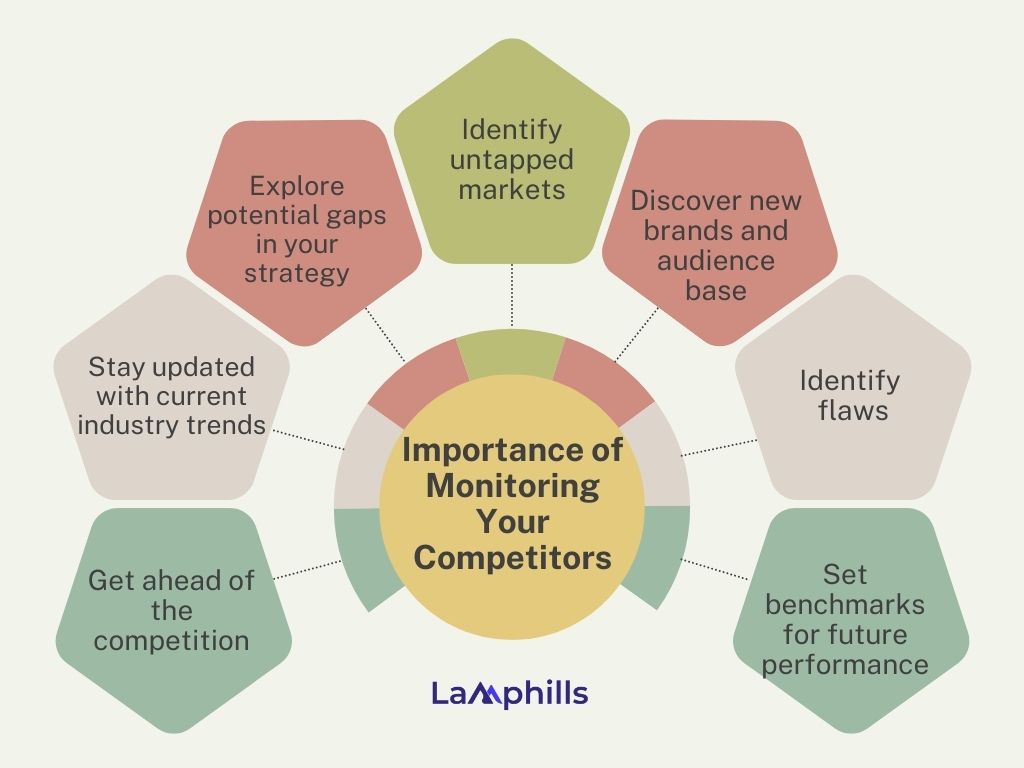Excelling in business takes more than just creating a revolutionary product or service and pushing it to market. No matter how good your offer is, you can bet that your rivals will have something similar in the works. This is why it is very important to monitor your competitors, so you won’t be left out in the cold.
To put it simply, navigating the digital world without monitoring your competitors is like trying to run a marathon blindfolded. You just shouldn’t do it.
To really stay ahead of the curve and pull away from your competitors, you have to know all there is to learn about them — from how they operate to how they capture the attention of their customers to how they plan to win the battle for market share. With this intel, you’ll make strategic, data-driven decisions, anticipate market shifts, and identify your competitors’ untapped opportunities.
Key Points
- Competitor monitoring helps you to understand your industry and target audience more and determine which strategies can work for you to achieve more success.
- There are two key types of competitors that you should regularly monitor: direct competitors and indirect competitors.
- There are also multiple factors to focus on, like price tracking and product development, depending on your industry and position within an organization.
- To monitor your competitors, you need a smart, organized strategy combined with the right competitor analysis tools.
- Competitor monitoring tools help automate the process to deliver standard results.
- Monitoring your competitors can help your brand in many ways by improving your marketing and pricing strategy
What Does It Mean To Monitor Competitors?
Competitor monitoring is a strategy by which you attempt to identify your potential competitors, learn their actions (like marketing campaigns, content, website changes, etc.), anticipate their future moves, and determine their strong and weak points. It helps you to understand your industry and target audience more, do’s and don’ts, and determine which strategies can work for you to achieve more success.
The goal of competitive monitoring is to understand where (and how) your competitors are outperforming your brand and where there’s an opportunity for you to swoop in. It also involves collecting data on market trends and other key aspects of your industry landscape. You can then analyze this data to derive actionable competitive insights and develop long-term strategies to gain a competitive advantage.
Every business must monitor its competitors to remain ahead in the race and beat the competition by creating unique, profitable strategies.
Which Competitors Should You Monitor?
There are two key types of competitors that you should regularly monitor: direct competitors and indirect competitors. Here’s how to identify both:
Direct competitors
Direct competitors are businesses that have the same or similar offerings as your own business. These competitors should be your highest priority, as they pose the most immediate threat to your business.
If there’s one thing consumers have, it’s options – and lots of them. So, you can pretty much guarantee that potential customers will compare your offering to the offering of many, many others.
Let’s take Wendy’s for example. Their direct competitors would be other fast-food chains like McDonald’s, Burger King, Arby’s, and Chick-fil-A. In such a fiercely competitive arena, you can bet Wendy’s has entire teams dedicated to diligently monitoring and tracking their direct competitors to stay ahead of the competition.
The bottom line: in the face of so much competition, it helps to identify where your competitors fall short. This will help you better satisfy the needs of potential customers and win their business.
Indirect competitors
Indirect competitors are those that offer a different type of product or service than your business but still serve the same consumer base. They’re not as immediately threatening to your business as direct competitors, but it’s important to keep an eye on them.
Why? Because the insight you glean from tracking indirect competitors highlights new perspectives, approaches, and ideas that your business may have missed. It widens your scope of focus and broadens your view of the industry you’re in. As a result, it can spark new strategies to grow and adapt to the needs of your target audience.
For example, let’s say you run an at-home workout subscription. Your indirect competitors would be in-person gyms like Planet Fitness and Gold’s Gym. You both solve the same customer problem but in different ways.
What You Should Monitor
When it comes to monitoring competitors, there are multiple factors to focus on, depending on your industry and position within an organization. Here are 6 areas you can use competitor monitoring for:
Price tracking
69% of buyers say that price is the most important factor in their purchasing decision. Knowing competitor price points and which are offering consumers the best deals can provide insight into their strategies and where you could be winning or losing.
Pricing your own products and services without this intelligence means more guesswork and less confidence. Monitoring your competitors makes it easy to build a clear, real-time picture of market pricing.
Product developments
Companies that successfully introduce new products grow 60% faster than those that don’t. Being the first to know about product launches, updates, withdrawals, feature add-ons and more can offer insights that inform your own product roadmaps, leading to greater success and minimizing the impact of what others are doing.
If 95% of products fail after launch, learning from the strengths and weaknesses of others can help you avoid being part of that statistic.
Website monitoring
A competitor’s website can often contain a wealth of valuable information. Whether it’s their pricing, products, news, thought leadership content, or even the key messages they lead with, it can all reveal a lot about their strategies and help you identify strengths and weaknesses.
Competitor monitoring helps you know when any of this content changes, so you can plan or respond accordingly.
Financial tracking
86% of executives say that understanding competitors’ financial performance is important to their own company’s success. A lot of that information is published online and accessible if you know where to look. It can give you a clear indication of which competitors’ strategies are working or not – which in turn can help you adapt, evolve, and reprioritize as an organization.
Competitor monitoring allows you to dive into specific aspects of financial performance to build up a clear and accurate picture of the market.
Social media monitoring
Businesses that fail to monitor their competitors’ social media activity risk falling behind in terms of customer engagement and insights, which can lead to lost market share and revenue.
Seeing what topics competitors are talking about, what their opinions are, and how consumers are responding can give you a clear sense of their strategy and what’s resonating with your potential customers. Your voice and opinion will still be yours, but competitor monitoring can help you to clean up your strategy and make informed decisions about frequency and channels.
Investment tracking
Companies that closely monitor their competitors’ investment activity are more likely to identify emerging trends and opportunities for growth. Whether it’s an outward investment in another company, new technology, or more people, or an inward investment that’s likely to fuel future growth, investment news can point to major changes in your industry.
It could represent a new trend, which the organization needs to pivot towards and capitalize on, or a turnaround story that could undermine peers’ market share. Therefore, competitor monitoring can help you understand and prepare for what’s coming rather than reacting further down the line.
How to monitor competitors
Competitive monitoring is more than just watching what your competitors are doing. You need to actively collect, analyze, and use that data to your advantage.
To monitor your competitors, though, it is essential to identify them. You must know about your biggest competitors, industry leaders, and newcomers. Know where their target markets are and whether that matches yours. In addition, find where your competitors have expanded their marketing territory and their performance.
This will help you discover an untapped potential market for your products and services.
Ultimately, this means you need a smart, organized strategy combined with the right competitor analysis tools. Here’s a step-by-step guide to monitoring your competition and extracting insights:
Strategies for monitoring competitors
Why It Is Important To Monitor Your Competitors
Any business strategy seems incomplete without monitoring your competitors. Competitive monitoring forms the backbone of competitive intelligence. It deals with collecting insights that help your business stay ahead, adapt, and grow.
You should monitor your competitors to understand their moves to learn what to do and what not to do. It will help you know what strategies are working for your competitors, and if your audience is the same, you can also implement those strategies and possibly improve your current ones.
Here are some key benefits of competitive monitoring:

Get ahead of the competition
The biggest advantage of competitive monitoring is it provides you with the insight you need to gain the upper hand.
By keeping an eye on your competitors’ activities, you can learn from their wins and losses, develop foolproof strategies, better position your products, and differentiate your brand.
For example, you might anticipate a new product launch or business merger before it actually happens. This information can help you move quickly to launch a better product or develop strategies to prevent the merger from stealing your brand’s market share.
Stay updated with current industry trends
Things are always changing in business. There might be a new automation software slashing marketing costs in half. Customers might be demanding more eco-friendly products. Or there might be a new viral trend your competitors are all hopping on.
Studying your competitors gives you an idea about what’s trending in your industry and helps you stay updated with all the buzz. You’re able to adopt new technologies earlier, align your offerings with customer preferences, pivot your strategies, and avoid missing out on short-term but potentially lucrative marketing trends. Thus, you can use this information to shape your campaigns, products, and services.
Keeping up with trends is vital to offer what your target audience is looking for instead of continuing the same old pattern that has become obsolete and possibly driving your customers away.
Explore potential gaps in your strategy
Competitive monitoring isn’t just about looking at what others are doing. It’s also about understanding your own strengths and weaknesses. Analyzing your competitor’s social media might reveal gaps in your own strategy. Maybe you need to share more engaging content. Maybe you’re using outdated formats or posting at the wrong times.
Studying your competitors can also highlight weaknesses in your products, services, business model, and other areas that could use innovation and improvement.
Identify untapped markets
Tracking competitor weaknesses, shifts in customer demand, market trends and potential threats allows your brand to capitalize on new opportunities before others do.
For instance, you might spot some niche market segments your competitors might be neglecting, like a different age group or interest. Or, you might find their customers are asking for a new feature. You could add that feature to your product before they do to steal their subscriptions.
Discover new brands and audience base
A large number of start-ups and new businesses have been set up in recent years. So, if you don’t know who you are fighting with, how can you win the battle?
When you monitor your competitors, you can learn new competitors and their strategies that have helped them make a good impact on the audience. You can use this data to reshape or optimize your strategy and ensure you stay ahead of the race.
Furthermore, monitoring competitors helps you learn the new audience base your competitors are targeting. It can be a potential opportunity to make more sales and revenue.
Identify flaws
It’s easier to spot others’ mistakes than your own, and probably cheaper too. Using the data gathered from your competitor monitoring and analysis, you can draw conclusions like issues associated with your rivals’ marketing strategies. You can then compare it with yours to figure out if you are making the same mistakes. If you are, you can correct them easily.
This will be a learning opportunity for you as to what not to include in your marketing strategy.
Set benchmarks for future performance
Monitoring the competition helps you set realistic goals for your business. This could be sales targets, customer satisfaction scores, the number of sign-ups, or engagement rates.
For example, you might find your competitor consistently gets good reviews on Google about their customer service. This could help you set benchmarks for your customer service team so they can try to snag as many or more positive reviews by the end of the quarter.
Or, competitive monitoring could reveal your competitor is ranking on search engines for several high-volume keywords related to your niche. Your goal could be to outrank them by creating quality content around those specific topics.
Top tools to help you monitor your competitors
Competitor analysis tools help your agency track, analyze and learn from their competitors’ strategies. There are lots of tools out there, and knowing which one will work best for your client’s audience can be tricky. That’s why I’ve narrowed down our top choices that save you time while identifying valuable data you might otherwise miss.
Use this information to boost your current marketing strategies to help them win big.
Semrush
Semrush helps you plan, analyze, and improve your client’s Google Ads campaigns. It includes features such as advertising and PLA research, PPC keywords tools, position tracking, and social media ad campaign tools.
All you need to do is enter a website and it will reveal information about your client’s biggest competitors, including top keywords and more.
Semrush also gives you insight into how much competitors are spending, although the accuracy can be debatable. At the end of the day, it’s a useful tool for clients who are advertising on multiple platforms.
Google Ads Auction Insights
This tool can only be used effectively when you’re running a live campaign for your clients. However, Google Ads Auction Insights can still provide you with actionable insights as long as you keep an eye on the Auction Insights tab regularly.
Basically, it lets you compare your client’s performance with other advertisers who are participating in the same auctions that you are.
Facebook Ad Library
Keeping track of social media PPC mentions is important, too. Use tools such as Facebook Ads Library (AKA Meta Ads Library) to search for ads across Meta Products–currently active or not. Find out who created the ad, what it looks like, and when it ran.
Make your client’s ads more effective by studying competitors’ ads that are performing well.
Sprout Social
Sprout Social is a powerful tool for monitoring competitors on social media platforms like Facebook, Instagram, and X (formerly Twitter.) You can benchmark metrics and compare performance with tailored competitor reports. You can also use Premium Analytics to dive deeper and access more insights with interactive charts and graphs.
Finally, Sprout’s listening tools also let you monitor public conversations about your competitors and your own brand, understand customer sentiment, and identify trends.
Ahrefs
Ahrefs is a great “all-in-one” platform that gives access to tools for link building, keyword research, competitor analysis, rank tracking, and site audits. Their keyword explorer tool helps you discover countless keyword options while analyzing their competitiveness. You can also calculate traffic potential and other key metrics such as global search volume, location-specific search volume, and average clicks.
Ahrefs is ideal for optimizing Google Ads campaigns and gives valuable insights on weak and low-potential keywords so you don’t waste your client’s budget.
SpyFu
This PPC competitor analysis tool gives you insights into the keywords, bidding, and ad strategies (within Google Ads) that your client’s competitors are using. It also allows you to see every keyword they’re purchasing and every ad they’re running.
SpyFu lets you get a deeper understanding of the competitors’ ad strategies which can inform you how to optimize your clients.
Conclusion On How To Monitor Competitors
Monitoring your competitors can help your brand in many ways by improving your marketing and pricing strategy, shaping your products and services, and attracting more customers.
As a result, you can witness more marketing success and improved sales and revenue.
Recommended Articles
- Risk Intelligence: Why Is It Important?
- Brand Advertising: Elevating Your Brand Awareness
- Social Media Etiquette: Best Practices
- MARKETING PROJECT MANAGEMENT: Unveiling Insider Tips and Strategies for Success
- Corporate Communications: Strategies to Amplify Your Brand’s Message
- What Does Evergreen Mean In Business? Timeless Tactics for Lasting Growth






